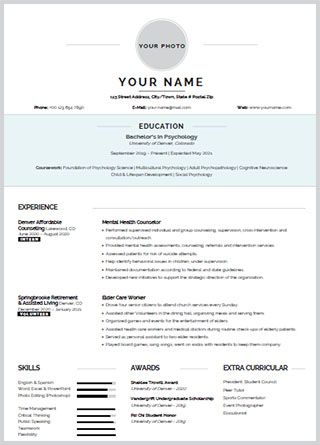A Résumé for Graduate School is one of the essential prerequisites for applying to a master’s program. Submitting a Resume with your transcripts and other relevant documents is standard practice with most universities. Resumes allow admission committees and panels to skim across applications and filter candidates they think they can make it through.
Writing a Resume is pretty straightforward and does not need training or expertise. Once your objective for the grad school to which you are applying is set, you can write a standout Resume in a matter of hours, with just a few guidelines, tips, and suggestions to help you. Moreover, there are loads of grad school Resume examples you can find online – for you to draw inspiration from and be guided by. So fear not, for by the time you are through with this article, you will be confident of writing a Resume par excellence!

Table Of Contents
Why Do You Need a Grad School Resume?
A Resume for graduate school allows an admission committee to capture as much information as possible about you in very little time. Since such committees handle hundreds and sometimes thousands of applications, Resumes help them short-list candidates for the next round of the admission process. In many cases, Resumes are the basis for categorizing forms and candidates based on several criteria. So, getting your Resume right and divulging vital information is imperative to help you with your admission to a grad school program.
In other words, a Resume for graduate school may be considered a summary of your academic and professional life. Most universities have made this an integral part of the admission process and, therefore, a key admission requirement. However, some universities ask for a CV for graduate School, but that is a different matter altogether.
Grad School Resume Template
A Resume for grad school should always consist of 5 main sections, without which it would be incomplete. Together, these sections make for a good and widely accepted template, making writing your Resume easy.
The five main sections of a graduate school Resume template are:
- Heading
- Education
- Experience
- Skills
- Additional Information
Graduate School Resume Components
Breaking down the five main sections of a Resume for graduate school is necessary to cover all points you wish to convey or all you are expected to convey. Most of the components listed below are essential, but some could be omitted depending on the program you are applying for and the university’s requirements.
- Create A Bold Header
Begin with creating a bold and stylish header that instantly captures the reader’s attention. Highlight your Full Name at the very beginning and continue with your Phone Number, E-Mail Address, Postal Address (optional), and Social Media Handles – such as LinkedIn (optional but important if you have one). - List Out Academic Accomplishments
List all your academic accomplishments, but be mindful of how far back you go. In most cases, universities are not interested in your Kindergarten or Elementary School unless they have asked for a Curriculum Vitae. Having said that, arrange your academic history chronologically, preferably with the latest being on top. Each listing should contain the Institution’s name, location, affiliation, GPA, and honors. If you mention a current program from which you have yet to graduate, add a probable month and year of graduation. - Specify Coursework, Internships, And Volunteer Work
One way to add coursework, internships, and volunteer work is to include them along with your academic accomplishments – especially if they are directly related to the program. Alternatively, you can create a separate section and list them all in that section. Either way, make sure you cover the core subjects of the program, any internships you undertook, and field or volunteer work you signed up for. - Call Out Professional Experience
This component is a very important one, not to be missed. If you are a working professional, list your work experience by order of time and provide details such as the employer’s name, dates or tenure of work, job title, department, and chief roles and responsibilities. On the other hand, if you are a student, you could skip this and move on. - Include Publications
Depending on the program you are applying for and the university in question, you may want to include any publication you may have made during or after your studies. If such is the case and you do have something to showcase, add them to your Resume with a heading, 1-to-2-line description and when and where it was published. - Highlight Skills and Certifications
If, during your studies, you were certificated or even licensed for anything related to your program, highlight it in your Resume. Also, list hard and soft skills you have acquired along the way, which do not necessarily come with a certificate. - Feature Awards, Grants, and Honors
Your Resume should also feature any awards and grants you received during your education. Include details such as the title, institution responsible for it, amount, reason, etc. If you bagged any honors for your studies, add them with relevant details as well. - Mention Extracurricular Activities
If you have been a keen participant at a lit club, took part in theater, or played a sport, add them all up in your Resume. Certain activities can help you gain favor if they are relevant to the program you are applying for. Besides, some universities award scholarships based on extracurricular activities. - Add Additional Information
Anything the components above do not cover may be added at the tail of your Resume. If there are points you wish to make that fall outside of the scope of these standard components, but you still find relevant, proceed to bake them in. However, do not go overboard and supply excessive, irrelevant, or uninteresting information.
Graduate School Resume Template Details
Keeping your graduate school Resume template clean and simple is an excellent way to grab someone’s attention. Too much detail and divulging uncalled-for information will put the reader off and dilute your key points and highlights. A good Resume is meant to be a snapshot or summary of who and what you are, so keep it as short and precise as possible.
As far as details for each section or component go, provide only what is necessary and which you think will add weight to your Resume. Emphasize your scholarly and other achievements while highlighting your capabilities, skills, and experience. Overall, you must keep your resume’s objective, to the point, and sincere.
How to Write a Grad School Résumé
Keep a few things in mind while writing your Resume for Graduate School. Listed below are some critical guidelines and best practices that will help you write a formidable one with relative ease:
- Be Aware of Program Requirements
Before you begin writing your Resume, check the university’s program requirements and see if there is anything specific you have been asked to cover. If so, note it and compile relevant data to add to your Resume. - Keep it Concise and Succinct
Refrain from beating around the bush and making your Resume lengthy. Unusually long Resumes are often not read, and more pages do not imply a better Resume. - Go with an Easy-to-Follow Format
Simplicity is the key to a standout Resume. Make your Resume clutter-free and presentable, with distinguishable elements and content at first sight. The reader should be able to easily grasp all information without looking for something in particular in an obscure part of a page. - Flow Logically
Let the information in your Resume flow naturally. Do not break a section up only to continue with it somewhere down the line. Everything should be logically arranged, structured, and seamless. - Style Professionally
Use a smart font and a decent font size, such as 11 or 12 pts. Try not to decorate your Resume too much with italics, bold text, or underlined text, or for that matter even a combination of them all. If you must use color, apply soothing shades that do not stick out like a carrot in an omelet. Also, space your lines so that everything is clear and legible. - Make it Error-Free
It is very easy to make errors and commit typos when preparing your Resume. Silly mistakes can often cost you much. Check your grammar, vocabulary, punctuation, and spelling for errors and correct them immediately. - Proof-Read
Proofreading is THE most critical part of writing a Resume. In the interest of being done and over with this document, students often forget to or simply do not want to review what they have written. It is always best to print out your Resume, read it several times over from start to finish and ensure that everything is as it should be. Another good practice is to pass on a copy to someone close to you – a friend or mentor – and get them to provide you with feedback or suggestions before you finish the final copy. - Publish or Print
If you have been asked to submit a written or hard copy of your Resume, have it printed on good-quality paper. See that the printed papers have no “dog ears” or are creased and crumpled. Refrain from folding or excessively pinning the sheets as well.
On the other hand, if you have been asked to upload your Resume online, export or create a file in the Portable Document Format – commonly known as PDF. PDFs are standard and universally accepted. However, in doing so, it is a good idea to encrypt the document and disable editing. Furthermore, keep the file size below, say 2MB, so it can easily be shared or downloaded.
Grad School Resume Examples
There are hundreds and thousands of grad school Resume examples available online. A simple search will pop up some compelling reads, but we suggest you keep them only as references and build your Resume from the ground up. Based on the sections, components, and guidelines of a Resume, here is an example to show you how yours could look:

FAQs About Grad School Resume
What should a grad school resume look like?
A standout grad school Resume should look clean, simple, and professional, with all relevant and factual data in a simple format.
What to put on grad school resume?
How long should a resume be for graduate school?
How to write an academic CV for a master’s application?
How to write a career objective for graduate school?
What is the difference between a Resume and a Curriculum Vitae?
Additional Resources for Writing a Résumé for Graduate School
There are several resources you could tap into for writing a standout Resume for graduate school. Traditionally, your teacher or mentor would be able to help you stitch one together, but there are options you could explore online as well. Here are a few that might be of help:
- University of Nebraska Omaha – University of Nebraska Omaha offers Resume and Cover Letter Resources. This site has ready-to-use templates for Resumes and sample Resumes for specific graduate programs or Careers.
- Career Services – Career Services by the University of Richmond is a wealth of resources for those wanting to write a Resume for grad school. Tips and samples are available, as well as help with formatting and grammar.

 Edited By
Edited By 
